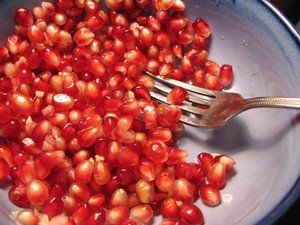The leaves are opposite or sub-opposite, glossy, narrow oblong, entire, 3-7 cm long and 2 cm broad. The flowers are bright red, 3 cm diameter, with five petals (often more on cultivated plants). The fruit is between an orange and a grapefruit in size, 7-12 cm diameter, has a thick reddish skin and many seeds. The edible part is the brilliant red seed pulp surrounding the seeds.
The only other species in the genus, Socotra Pomegranate Punica protopunica, is endemic on the island of Socotra. It differs in having pink (not red) flowers and smaller, less sweet fruit.
Cultivation
Pomegranates are drought tolerant, and can be grown in dry areas with either a Mediterranean winter rainfall climate or in summer rainfall climates. In wetter areas, they are prone to root decay from fungal diseases. They are tolerant of moderate frost, down to about -10°C.
Uses

The arils (seed casings) of the pomegranate are consumed raw. The entire seed is eaten, though the fleshy outer portion of the seed is the part that is desired. The taste differs depending on the variety of pomegranate and its state of ripeness. It can be very sweet or it can be very sour or tangy, but most fruits lie somewhere in between, which is the characteristic taste.
The acidic juice of pomegranates is used in Indian cookery; thickened and sweetened it makes grenadine syrup, used in cocktail mixing. The juice can also be used as an antiseptic when applied to cuts.
Pomegranate seeds are sometimes used as a spice.
Pomegranates in mythology
Pomegranates are a symbol of fertility because of their many seeds, yet of death because of the vivid blood red of the pulp. (See life-death-rebirth deity.) In mythology, Persephone was condemned to spend time in the Underworld every year because Hades tricked her into eating six pomegranate seeds while she was his prisoner. The pomegranate was a symbol of the Aegean Triple Goddess who evolved into Olympian Hera, who is represented offering the pomegranate. See also Orion (mythology).
In the development of European iconography, the pomegranate developed into the Orb that a monarch holds at coronation. Maximilian I, Holy Roman Emperor adopted it as his personal emblem; it appears in the Emperor's hand in Albrecht Dürer's posthumous portrait of him, 1519.
A pomegranate appears in the shield of Granada.
The pomegranate gave its name to the grenade from its shape, and to the garnet from its colour.
External links
- Pomegranate News (http://granatapfel.twoday.net/topics/News+Pomegranate/)

